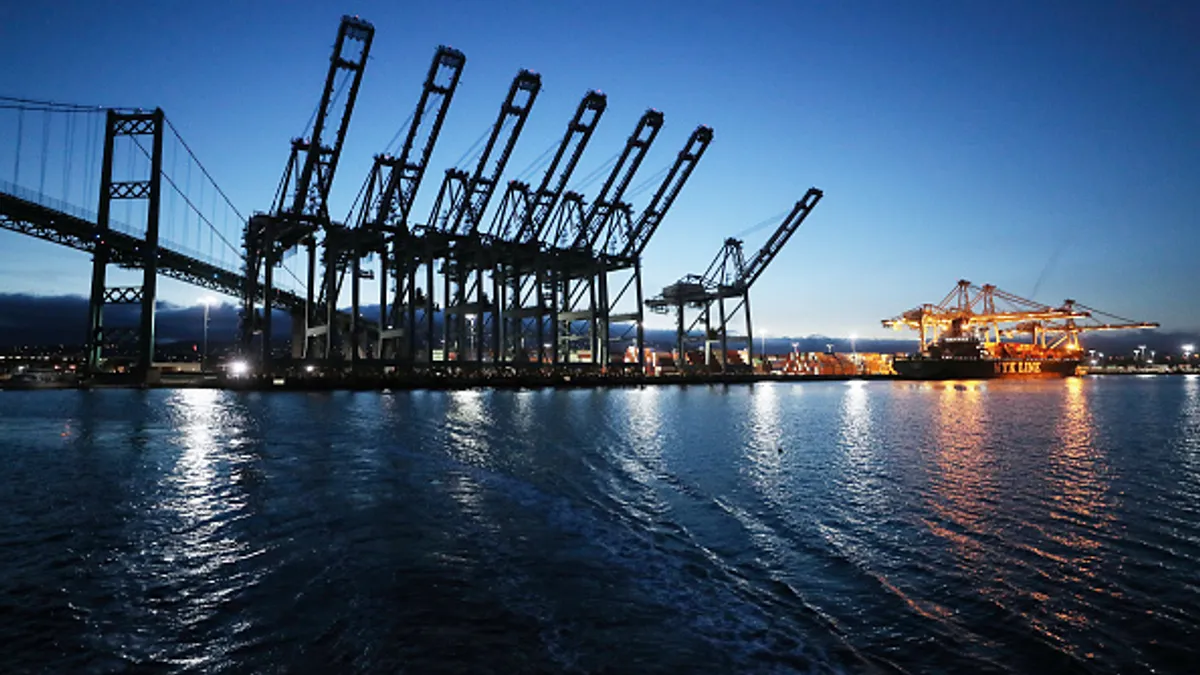Container volumes at the Port of Los Angeles are expected to soften this spring compared to last year, and the port will use any lull from COVID-19 lockdowns in China to keep tackling cargo backlogs, Executive Director Gene Seroka said in a briefing Wednesday.
Retailers plan to replenish low inventories, which should help imports remain at "solid" levels, even if they dip from the 970,000 TEUs on average between March and May of 2021. And the ripple effects of factory shutdowns in China might even benefit port operations, Seroka said.
"In the event we have a lull due to shutdowns at ports, terminals, factories, other businesses that convey the cargo, it’s going to give us a chance to catch up even more so than we have done right now," he said.
The remarks, delivered from New York, came during the Port of Los Angeles monthly briefing on cargo volumes and other performance indicators. The nation’s largest container port handled 857,764 TEUs, a February cargo record, and processed 338,251 TEUs of empties — an 18.6% increase YoY — last month amid record levels of empty repositioning back to Asia.
The port has also seen the proportion of imports to exports continue to rise. Imports increased 2.7% to 424,073 TEUs YoY, while exports fell 5.7% YoY to 95,441 TEUs, the 36th decrease in the past 40 months.
Seroka pushed back on the phrase "port congestion" during the briefing and continued to cite the port's roughly 55% of unused truck gate appointments as an issue keeping the port from unlocking its full potential.
"Is it chassis dislocation?" the executive director mused. "Is it the inability to service at the terminal because you've got to dig through so many containers? Long truck lines? Is it operational improvements that must be made? Are there other things that we're not seeing that have to be brought to the forefront?"
"Probably those and many more," Seroka said.
State and national governments are accelerating efforts to help the ports and other supply chain stakeholders ease congestion.
Dee Dee Meyers, director of the California Governor’s Office of Budget and Economic Development, joined the briefing to tout Gov. Gavin Newsom’s plan to invest a record $2.3 billion in California ports in the upcoming budget. The money includes a planned $1.2 billion dollars for port infrastructure and goods movement, including rail, roadway, bridge and zero-emission modernization projects.
"We're already talking to stakeholders about what their priorities will be, assuming we get these funds, and we will work very hard to make that happen," Meyers said.
On the national level, the Port of Los Angeles, the Port of Long Beach and the Georgia Ports Authority will pilot a data-sharing portal announced Tuesday by the White House.
The Freight Logistics Optimization Works program, which includes 15 companies at first, will build on lessons learned from the Port Optimizer platform, Seroka said.
"The Port Optimizer in Los Angeles will play whatever the role is outlined by the federal and state governments, along with our private sector partners," Seroka said. "There's some replications of best practices that can get this pilot up and running, and cut the learning curve down very swiftly."
There's another looming worry on local, state and national leaders' minds: port contracts.
The International Longshore and Warehouse Union bargaining with management in May is expected to extend beyond the June 30 expiration date, Seroka said. COVID-19 has hit the dockworkers union hard: More than 40 have died of the virus during the pandemic.
During Seroka's visit to Washington, D.C. Tuesday for the announcement of the data-sharing portal, he said, leaders at the highest levels of the government expressed a focus on the upcoming union negotiations and their implications for supply chains.
"The eyes of the nation are on this," he said.













